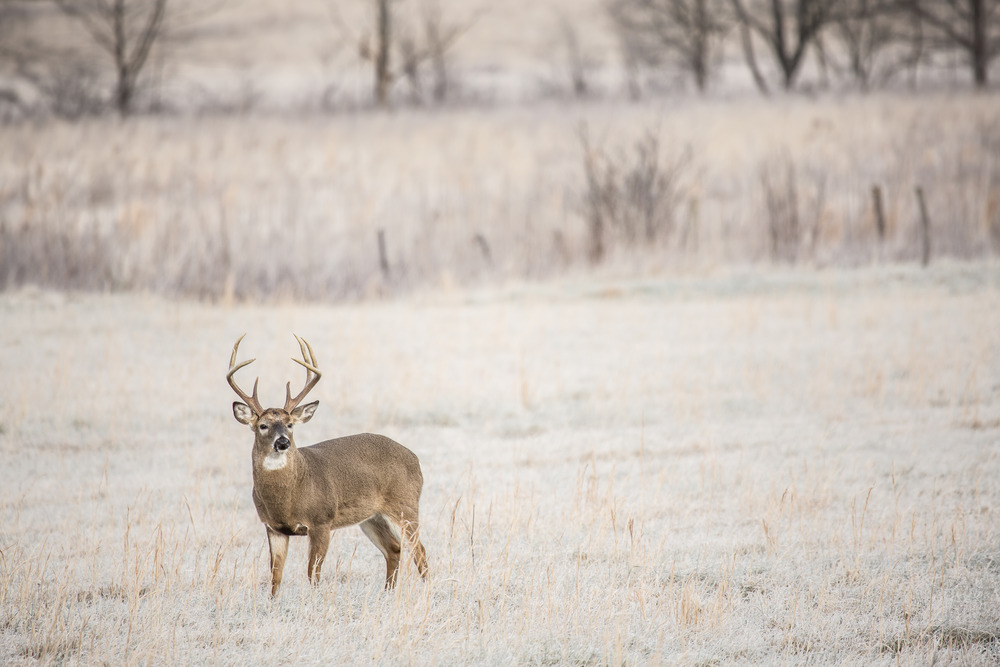No products in the cart.

A bitter breeze ruffles your hair and slips through your jacket. You shiver on your way to the stand as the wind chills your body.
During late-season hunts, you may face cool temperatures and sharp winds, making it imperative to choose suitable clothing. For cool weather, layering is the key. You want to select the proper fabrics and layer them according to the climate and activity.
Take a crash course in layering for cold weather hunts. After finishing this article, you’ll be ready for crisp mornings in the woods.
Jump to:
Two ways the human body regulates its temperature are sweating and shivering. A normal body temperature ranges from 97℉ to 99℉, though 98.6℉ is considered the average. You shiver when your body needs to raise its temperature, and you sweat when it needs to lower its temperature.
If you hike long distances, your body temperature will increase, causing you to sweat. The middle layer of your skin stores water. When sweat glands activate, they bring that water to the skin’s surface, where it evaporates and cools the body.
What does this have to do with your hunting gear?
Sweat dampens your skin. In cool weather, damp skin makes you feel colder. You want clothing that keeps your skin dry, so you can retain heat and avoid feeling clammy.
Winter hunting gear comes in many materials. Some are better than others for base layers or protective outerwear. For cold weather hunting, you should steer clear of cotton because it traps moisture against your skin.
Synthetic materials are moisture-wicking. They use capillary action to move liquid through spaces in the fabric. They are better for clothing that’s close to the skin or as outerwear to protect you from wind and precipitation. Clothing made from natural fibers may serve you well as middle layers.
When shopping for winter hunting gear, you will see clothing marked as “water-resistant” and “waterproof.” These descriptors are not the same.
Water-resistant clothes are best for drizzles. They will protect you from a light level of moisture but won’t do much in a downpour. On the other hand, waterproof items are ideal for rainy and windy conditions.
Look for outerwear with a durable water repellent (DWR) finish. Water beads on the fabric’s surface and rolls off with this finish. Both water-resistant and waterproof jackets use DWR coatings, increasing their ability to keep you dry.
If you’re headed into chilly weather, you want to stay warm but avoid overheating as you move around. Proper layering for cold weather hunting and other activities includes a base, middle and outer layer.
Each hunting layer serves a unique purpose to keep you dry, warm and protected from the elements.
A base layer’s duty: wick sweat off your skin.
Base layers are the clothes closest to your skin—or the first items you throw on. They help regulate your body temperature by taking moisture (sweat) from your skin and allowing it to evaporate.
As sweat evaporates, your body cools and your skin dries. Keeping your skin dry is essential for staying warm in cold conditions. Long underwear-style base layers, for example, are perfect for chilly mornings.
These are the best fabric choices for top and bottom base layers:
Never use a cotton t-shirt as a base layer. Cotton will absorb moisture without releasing it, leaving you feeling damp and chilled.
A middle layer’s role is to keep you warm.
Middle layers are your insulation. They help you retain heat by trapping it against your core. The thicker the material, the warmer you will be. Natural and synthetic materials can make great middle layers.
The last layer’s goal: protect you from the elements.
Outer layers shield you from wind, rain and snow. Your outer layer should be a synthetic material, like polyester or nylon. These fabrics repel water and may also be treated with a DWR finish.
Good outer hunting layers may have vents or adjustable hemlines and sleeves. Depending on the elements, you may need a regular coat, bib, or rain slicker and waterproof pants.
Waterproof/breathable shells are the best options for cold climates. They protect you from the weather without causing you to overheat. Often, these clothing items are the most expensive.
A water-resistant/breathable shell may work if you need something for morning drizzles but not winter snow. These shells are better for light rain and breezes. You’ll find that water-resistant/breathable outerwear is more affordable than waterproof/breathable options.
A soft shell is a lightly insulated layer. Soft shells are often two-layer jackets: one layer for insulation and one for light weather protection.
Lastly, you should save waterproof/non-breathable shells for rainy days with no hunting plans. Since they focus solely on protecting you from the rain, you’re likely to work up a sweat while wearing one.
With this advice, you’ll stay warm and dry on your next hunting trip. Don’t forget to bring gloves, wool socks, stocking caps and hand warmers! If you’re trekking through snow, a good pair of sunglasses will help reduce glare.
Once you’re layered up, you’re ready for winter elements out West or a cool fall morning at your family farm.
Need a new place to hunt? Searching for hunting land to lease or an exciting guided trip?
Browse our listings, and discover your next adventure today. Once you find what you’re looking for, sign up to book it on HUUNT!
We make it simple to list and lease land, book guided hunts and more. Find your next hunting spot or guided trip. Earn extra income by letting others enjoy your land. HUUNT helps you make the most of every opportunity. Become a member today!